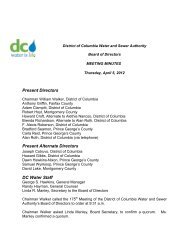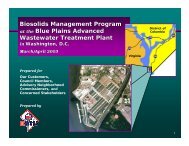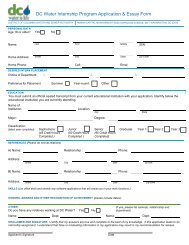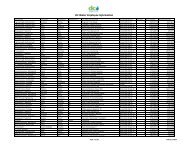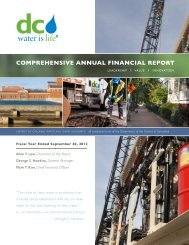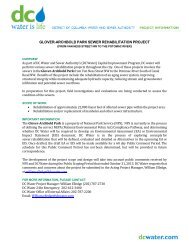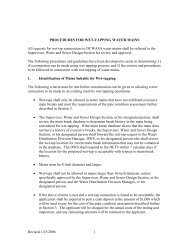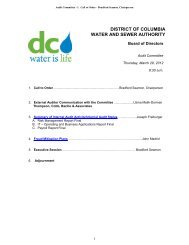Hist and Proj Operating Receipts FY 2011 2 17 2010 - DC Water
Hist and Proj Operating Receipts FY 2011 2 17 2010 - DC Water
Hist and Proj Operating Receipts FY 2011 2 17 2010 - DC Water
You also want an ePaper? Increase the reach of your titles
YUMPU automatically turns print PDFs into web optimized ePapers that Google loves.
Boys Town of Washington, <strong>DC</strong> - During 2009, <strong>DC</strong> WASA summer college interns painted the family center interior, removed<br />
shrubs, provided l<strong>and</strong>scaping <strong>and</strong> trash collection services. Also, for the fourth year in a row, a <strong>DC</strong> WASA staff member served as<br />
Santa for the children.<br />
Retail Rates <strong>and</strong> Fees - In 1997, shortly after <strong>DC</strong> WASA's creation, the Board eliminated all discounted <strong>and</strong> free service <strong>and</strong><br />
adopted a 42 percent rate increase to compensate for ten years without any increase <strong>and</strong> the resulting lack of maintenance <strong>and</strong><br />
investment in an aging <strong>and</strong> deteriorating water <strong>and</strong> sewer infrastructure. Since that time, there have been gradual increases in retail<br />
rates - ranging from 2.5 to 9.5 percent. This is a continued reflection of the Board's policy to keep rates reasonable <strong>and</strong> affordable in<br />
order to minimize the impact on retail customers. Additionally, since <strong>DC</strong> WASA does not make a profit, in years of better than<br />
expected performance, any excess revenues that are generated above the system need, are placed in a Rate Stabilization Fund<br />
(RSF) or are used to fund capital projects, both of which lower customer rate increases in the future. However, the RSF has been<br />
drawn down by approximately $25 million in both <strong>FY</strong> 2008 <strong>and</strong> 2009 <strong>and</strong> it is anticipated that additional draw downs will be made in<br />
<strong>FY</strong> <strong>2010</strong> leaving very little to underwrite rates in <strong>FY</strong> <strong>2011</strong>. The use of the RSF in <strong>FY</strong> 2008 <strong>and</strong> 2009 reduced needed rate increases<br />
by approximately 9.5% <strong>and</strong> helped to avoid rate shock in those years.<br />
We have carefully reviewed our Ten-Year Financial Plan <strong>and</strong> near-term rate increases required to provide sufficient revenues to<br />
cover our capital program <strong>and</strong> resulting debt service costs over the same period. Our budget proposal includes use of $2.6 million<br />
from the RSF in <strong>FY</strong> <strong>2011</strong>, a $0.77 per Cd combined retail water <strong>and</strong> sewer rate increase in <strong>FY</strong> <strong>2011</strong>, following a 9.0 percent<br />
increase approved in <strong>FY</strong> <strong>2010</strong>, an increase to the Customer Metering Fee of $1.85 per month <strong>and</strong> an increase to the lAC of $1.24<br />
per monthly ERU. With these proposed changes in <strong>FY</strong> <strong>2011</strong>, the monthly impact to the average residential customer will be $8.66;<br />
about the average cost of one lunch at a s<strong>and</strong>wich shop in downtown <strong>DC</strong>.<br />
<strong>DC</strong> WASA's proposed rate increases are primarily required to collect the revenues previously under collected due to the existence of<br />
a large rate stabilization fund, adjust for revised trends in consumption <strong>and</strong> to pay for increasing debt service costs, which will rise<br />
from approximately 24 percent of the <strong>FY</strong> <strong>2010</strong> budget to 26 percent of the <strong>FY</strong> <strong>2011</strong> operating expenses. These debt service costs<br />
finance the District's share of <strong>DC</strong> WASA's proposed $3.8 billion capital program, which is discussed in more detail later in this book.<br />
In addition to the proposed retail rate increases, we are proposing an approximate $0.06 per Cd increase in the PilOT fees alone to<br />
ensure that we fully recover the costs of this District of Columbia fee. This fee represents costs assessed by the District of Columbia<br />
since 1997 <strong>and</strong> rise in accordance with increases in the volumetric retail rates. Through <strong>FY</strong> 2009, <strong>DC</strong> WASA has paid over $153.1<br />
million in the PilOT fee. The ten-year plan projects annual increases to the PilOT fees between $0.8 million to $1.9 million.<br />
<strong>DC</strong> WASA's current <strong>and</strong> proposed rates <strong>and</strong> fees remain very competitive with other water <strong>and</strong> wastewater providers 'in the mid-<br />
Atlantic <strong>and</strong> the eastern United States. In fact, the <strong>FY</strong> 2008 independent comprehensive budget review noted that <strong>DC</strong> WASA's recent<br />
rate increases have been much lower than other similar utilities. <strong>DC</strong> WASA's proposed monthly residential bill (including the lAC,<br />
Budget Overview <strong>and</strong> Performance<br />
II - 15



